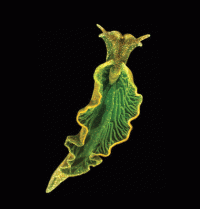January 12, 2010 report
Green sea slug makes chlorophyll like a plant

(PhysOrg.com) -- Scientists from the University of South Florida in Tampa have found a green sea slug is able to synthesize chlorophyll like a plant, which makes it the first animal known to be capable of the feat.
Researcher Sidney K. Pierce said the super green sea slug, Elysia chlorotica, which lives in waters on the east coast of the USA and Canada, is known to steal genes and photosynthesizing organelles called chloroplasts from its favorite intertidal algae species, Vaucheria litorea, but it now seems it has developed an entire chemical pathway to manufacture the green pigment "chlorophyll a" itself.
Chlorophyll is the pigment that captures energy from sunlight in photosynthesis. Pierce and his team used radioactive tracing techniques to determine the slugs were manufacturing the chlorophyll themselves and it did not originate in the algae they ate.
A number of animals (such as corals) host microbes and algae and benefit from their photosynthesis, but in most of these associations the cells remain whole. In Elysia chlorotica, in contrast, the cells are broken down and chloroplasts are extracted and held inside the slug's own cells, where they remain active for the slug's lifetime of almost a year. Researchers have shown that once a young slug has eaten a meal of Vaucheria algae it never has to eat again as long as it has access to light and supplies of chlorophyll and other chemicals used in photosynthesis.
In 2007 scientists, including Pierce and his team, found genes related to photosynthesis in the slugs, and these genes, apparently originally from the algae, were even found in unhatched slugs that had never eaten algae. In the latest research Pierce found more algal genes, and some of them were for enzymes required for the chemical process manufacturing chlorophyll.
Pierce and his team studied slugs that had not eaten anything for at least five months and had stopped eliminating waste digestive products. They contained chloroplasts taken from the algae, but Pierce said that any other part of the algae should have long ago been digested. They gave the slug an amino acid labeled with radioactive carbon and found that the radioactive carbon turned up in the chlorophyll a molecule after the slugs had been sunbathing, but not if they had been in the dark.
The findings were reported at the annual meeting of the Society for Integrative and Comparative Biology in Seattle, Washington on 7 January and will be published in the journal Symbiosis.
© 2010 PhysOrg.com
















